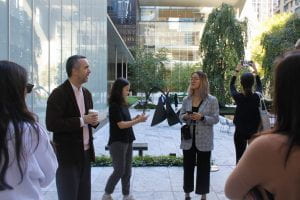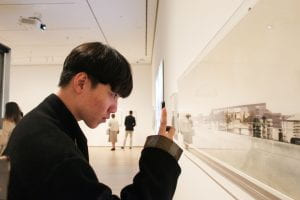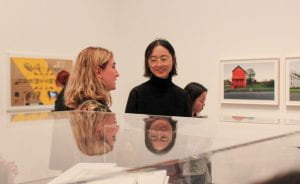
As part of our Theory of Architecture elective, Bordering, taught by Cornell Alumni Sean Anderson (B.Arch./B.S. ’96), we visited the Modern Museum of Art (MOMA) after it newly opened after 5 months of closure. The “new” MOMA as we see it today has opened its doors after a westward expansion campaign that has added up to 30 percent more gallery space.
The MOMA’s humble beginnings began in 1928, when three ladies Abby Aldrich Rockefeller and two of her friends, Lillie P. Bliss and Mrs. Cornelius J. Sullivan conceived the idea for the museum with the goal of popularizing and showcasing modern art in the United States. The museum first opened in 1929 in an existing building on 57th Street and slowly expanded over the years to what we see today. Several architects over the years, Philip L. Goodwin, Edward Durell Stone, Philip Johnson, Yoshio Taniguchi, DS+R and many others collectively contributed to the design of the museum. As we walk down the hallways, it is interesting to note the old parts of the museum inter-woven with the new.
During our visit we specifically looked at the architecture and design galleries. Unlike the old MOMA where previously architecture and design galleries were separate from the art galleries; in the new MOMA, architecture and design galleries were interwoven and placed amongst the art galleries, creating an all immersive experience. Art, architecture and design are now in dialogue with each other, creating meaningful adjacencies by reinforcing thematic ties. By dispersing the architecture and design galleries, the goal is to create an overall understanding of history.


We begin our journey at the section “Architecture for Modern Art.” The section featured early proposals and drawings of the MOMA by architects Phlip L. Goodwin and Edward Durrell Stone as well as Gorge Howe and William Lescaze. With these early explorations’ architects were trying to explore how architecture is embedded within art and how we might imagine the presentation of art within these spaces. Proposals ranged from the scale of a cabinet to that of a tower with architects and designers carefully curating the experience of the viewer. As one looks at the MOMA today, one might come to a network of interlocking spaces that encourage serendipitous discoveries and open-ended associations between works. Other works that were featured was a model of the Guggenheim by Frank Lloyd Wright as well as collages by Mies Van Der Rohe and Heinz Loew which explores the organization of spaces and ways of looking.
We then quickly transitioned into “Design for a Modern Life”, which focused on the themes of the production of labor, domesticity and work as well as leisure. There we saw works from the Bauhaus movement, which included a recreation of the Frankfurt Kitchen by Grete Lihotzky and the Minimal Dwelling Project by Albrecht Heubner among others. The whole post-World War I (WWI) era was focused on rethinking existing lifestyles to one that was more efficient, rational, unpretentious and socially oriented. It was conceived to build a better, egalitarian world. The section was connected to that of “The Vertical City,” in which the origin of steel production begins to give way to the technology for building towers. There we saw a film on the production of the elevator which changed the way in which we saw our cities. Both artists and architects begin to represent the transforming urban landscape in new ways by exploring the sensorial impact of the city’s expanded scale, accelerated pace of movement and vertiginous heights.
Moving forward in time, in the decades following World War II (WWII) architects began to be preoccupied with the ideas of “Architectural Systems” in which architectural projects were being conceived as a series of variable components that would begin to interact in a larger system. These ideas began to appeal to radical architecture groups, artists and filmmakers with the likes of Superstudio, Constant, Ettore Sottsass, Archigram as well as Mies van der Rohe among others who began to imagine how these systems might empower inhabitants to reshape their environments to their own needs and desires.
Our final stop, “Building Citizens” featured works from contemporary architects that blends different narratives together to talk about politics and space. It creates a sequence of ideas centered around borders, materiality, production and representation. It follows a timeline from the 1970s to the 2000s, featuring works by Gordon Matta Clarke, Peter Eisenman, Zaha Hadid, Rem Koolhaas, Anupama Kundoo as well Amanda Williams amongst others. As we look at these works on the theme of housing, we begin to question for whom architecture is built for and how might we understand the design and making of spaces by everyone. Is it possible to design a house, a neighborhood, or even an entire nation that creates a sense of belonging for all its inhabitants? How can we create spaces that address the diverse needs of individuals? How does architect begin to address and subvert civic values?

As we ended our visit, we begin to think about how we can address these issues within our own studio projects focused on housing projects in Long Island City and Brownsville. How can we empower individuals in these communities and how can architecture and development bring people out of poverty to change the narrative of displacement within the city? With its new curatorial approach and strategy, the “new” MOMA has challenged old narratives and brought new narratives to surface.
